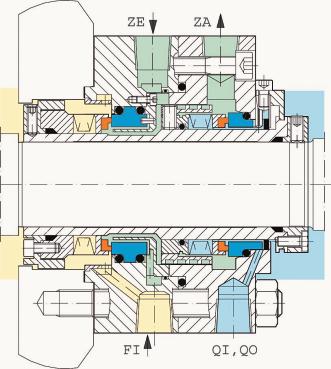The new German Technical Instructions on Air Quality Control (TA-Luft 2002) stipulate significantly lower emission values compared to previous regulations. Stricter requirements are specified for pumps, compressors, flanges and valves used to pump, process and store certain liquid organic media. To meet these new regulations, a quarter of all pumps in a large German refinery are currently being equipped with double mechanical seals.
Hans J. Rabl
Even in the late nineties, emissions of hydrocarbons from German refineries amounted to less than 0.02 % of all processed crude oil, depending on the facility and the production volume. The enforcement of the German Technical Instructions on Air Quality Control (TA-Luft 2002), which prescribes precautionary action against harmful environmental impacts, will lead to a further reduction in emissions. According to the new regulation, “technically tight pumps, such as magnetically coupled pumps, canned pumps or pumps with multiple mechanical seals and pressureless or pres-surised barrier fluid …” are mandatory for certain liquid organic media.
Close collaboration
In a large German refinery with a capacity of 12 million t/a, the relevant applications and the affected pumps were defined and identified according to German TA-Luft regulations. It was discovered that approximately 25 % of all pumps in use at the time did not meet the new requirements. After evaluating all the approved solutions, it was decided to change the pumps over to double mechanical seals with corresponding accessories. Two thirds of the project was awarded to Chetra, the mechanical seal manufacturer. The first phase comprised converting the pumps in the FCC plant as well as the Combicracker. In practice, all these applications entail so-called hot pumps with operating temperatures of more than 300 °C.
Right from the outset, close collaboration and consultation were the order of the day between the refinery, the industrial service provider of the actual conversion work and engineers at Chetra. In addition to meeting regulations like TA-Luft and Atex 95, the solution had to ensure maximum standardisation as well as compliance with both API standards and the refinery’s own specifications. Furthermore, the mechanical seals had to fit the existing equipment without modification.
Completely pre-assembled units
The 875A mechanical seal, which offers individual gland and sleeve adaptation to each specific pump, was chosen for the changeover. This seal is a completely pre-assembled and ready-to-operate cartridge unit with a gland plate, shaft sleeve, feed screw and safety restriction bushing. Its guided circulation optimises the cooling effect at the seal faces. The inboard and outboard mechanical seals are high-temperature metal bellows units, which are balanced and independent of the direction of rotation. Circulation and flushing connections are integrated. Other technical data:
- pmax = 28 bar from outside the bellows
- pmax = 8 bar from inside the bellows
- t = –40 to +400 °C
- vmax = 25 m/s
- Method of operation: API Plan 53B
- Barrier fluid: Thermal oil
Accessories
A 600 LSH central barrier fluid feed system and a 10 CLS-BO loop system were installed as accessories. The central barrier fluid unit is designed for 50 pumps and has a vessel capacity of 600 l. This system provides a barrier fluid pressure of 100 bar. Each loop system is fed with 30 bar pressure via a pres-sure reducer. In addition to feeding the loop systems, the reducer also compensates any leakage losses. The central system is equipped with two pumps, a bladder accumulator and a heater as well as all required measuring and controlling elements. Each mechanical seal is served by one loop system. These systems feature an accumulator, heat-exchanger, fittings and measuring devices. The barrier pressure is set individually for each pump or mechanical seal. All consumption of barrier fluid is compensated by the accumulator. A coupling to the 600LSH central barrier fluid system safeguards the supply to the loop systems. Continuous monitoring takes place simultaneously via these systems, which send their signals to the control desk.
The project was awarded in July 2004 and the first installations were carried out in October the same year. The entire installation work for the first segment was completed in January 2005. The facility has been operating without any problems ever since. The complete system has proved to be practically maintenance-free and absolutely reliable.
cpp 406
More information on the products
VDMA-e-market seals
Achema 2006
Share:







